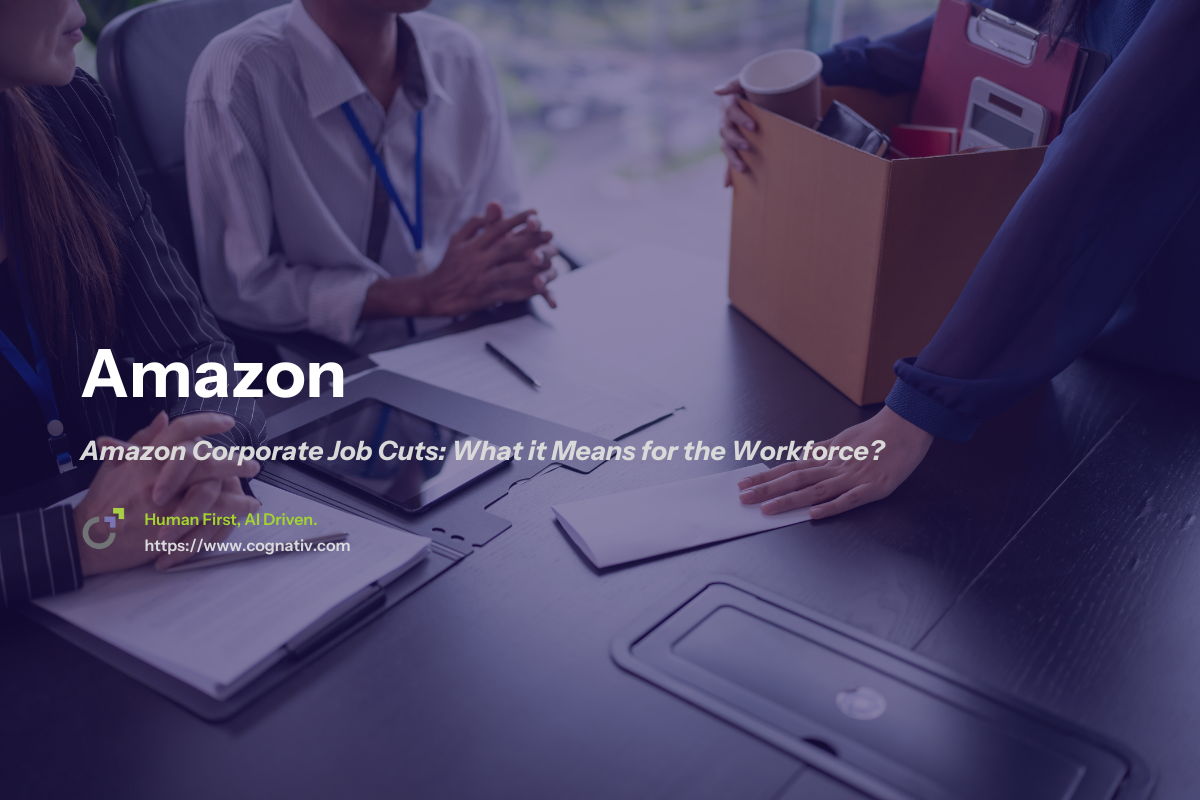

Tuesday, October 28, 2025
Kevin Anderson
Amazon Corporate Job Cuts: What it Means for the Workforce?
Amazon recently announced plans to cut as many as 30,000 corporate jobs, which represents roughly 10% of its total corporate workforce of about 350,000 employees. This move is part of a broader strategy to reduce bureaucracy, streamline operations, and shift resources toward the company's biggest bets, particularly in artificial intelligence (AI) and generative AI technologies. CEO Andy Jassy has emphasized the importance of becoming leaner and more efficient in order to stay competitive in a rapidly evolving tech landscape.
Senior Vice President Beth Galetti highlighted that the company aims to organize itself "more leanly, with fewer layers and more ownership" within corporate teams. This restructuring reflects Amazon's recognition of AI as the most transformative technology since the internet, enabling companies to innovate faster and automate routine tasks. The layoffs come as part of ongoing rolling layoffs that began in 2022, during which Amazon cut over 27,000 jobs, with more reductions expected in the coming years.
Despite these significant cuts, Amazon plans to support impacted employees through transition aid and opportunities to find new roles within the company. This approach aims to soften the impact of what is the biggest job cut in the company's history.
"We are committed to supporting everyone whose role is impacted, including providing severance pay and helping employees find new roles," said Beth Galetti, Senior Vice President of People Experience and Technology.
Key Takeaways
-
Amazon targets a substantial reduction in its corporate workforce, planning to cut as many as 30,000 corporate jobs, which represents roughly 10% of its total corporate employees. This move reflects the company's strategy to reduce bureaucracy and shift resources toward its biggest bets, especially in artificial intelligence.
-
The layoffs will hit multiple divisions, including human resources (People Experience and Technology), operations, devices, services, and AWS. These reductions are driven by AI-driven productivity gains and automation of routine tasks, enabling Amazon to operate with fewer employees while continuing to serve its customers' current and future needs.
-
Despite the significant job cuts, Amazon declined to comment extensively but has committed to supporting impacted employees through transition assistance and severance pay. The company expects more cuts in the coming years as it continues trimming smaller numbers of roles and adapting to the transformative technology landscape shaped by AI agents and generative AI.

Impact on Corporate Jobs: Divisions Affected and Workforce Changes
The job cuts will affect multiple divisions across Amazon's corporate landscape, including Human Resources (also known as People Experience and Technology or PXT), operations, devices, services, and Amazon Web Services (AWS). These cuts are expected to touch nearly every business unit, reflecting a comprehensive effort to reduce costs and increase efficiency.
CEO Andy Jassy has linked these workforce reductions directly to the company's increasing adoption of generative AI across divisions. AI agents and automation are expected to replace routine and repetitive tasks, allowing Amazon to operate with fewer employees while continuing to grow its business.
Amazon's corporate restructuring also aims to foster a startup-like culture by removing layers of management and reducing bureaucracy. Jassy has introduced an anonymous complaint line to identify inefficiencies, which has generated over 1,500 responses and led to more than 450 process changes. This initiative aligns with the company's goal of having fewer layers and more ownership, empowering employees to move faster and innovate more effectively.
Key Divisions and Expected Impact
|
Division |
Approximate Impact |
Notes |
|---|---|---|
|
Human Resources (PXT) |
Up to 15% workforce reduction |
Largest cuts expected in this division |
|
Operations |
Significant reductions |
|
|
Devices and Services |
Workforce trimming continues |
|
|
Moderate cuts |
Balancing growth with cost efficiency |

The Role of AI in Reshaping Amazon's Workforce
Amazon's leadership views artificial intelligence as the most transformative technology since the internet. CEO Andy Jassy noted in June that AI tools are enabling companies to innovate at unprecedented speeds. This shift is driving the company's decision to reduce its total corporate workforce over the next few years.
Generative AI, AI agents, and other automation technologies are expected to take over many routine tasks, allowing Amazon to focus human resources on more strategic roles. This transformation is not just about cutting costs but also about reallocating resources to Amazon's biggest bets, ensuring the company remains competitive in a fast-changing business environment.
Long-Term Investments and AI Infrastructure
Amazon's investments in AI infrastructure are part of a long-term strategy to boost efficiency and innovation. However, these investments also mean that the company needs to reduce its workforce in some areas to balance costs. Sky Canaves, an eMarketer analyst, commented that Amazon is likely realizing enough AI-driven productivity gains within corporate teams to support a substantial reduction in force.
"This latest move signals that Amazon is likely realizing enough AI-driven productivity gains within corporate teams to support a substantial reduction in force," said Sky Canaves, eMarketer analyst.
The company plans to continue hiring in key strategic areas, reflecting a shift toward roles that require new skills and expertise in AI and technology.

Organizational Changes and Workforce Support
One of the central goals behind the layoffs is reducing bureaucracy. Amazon CEO Andy Jassy has been focused on removing layers of management to create a more agile and efficient organization. The company aims to operate more like the "world's largest startup," where employees have more ownership and accountability.
Managers of impacted teams were required to undergo training on how to communicate layoffs effectively and compassionately. This training is part of Amazon's effort to manage the transition responsibly and maintain morale.
Supporting Employees Through Transition
Amazon has pledged to support employees affected by the layoffs by offering transition assistance, including severance pay and help in finding new roles within the company. However, some employees who do not meet the company's return-to-office requirements have been told they voluntarily quit and may leave without severance, which has been a point of contention.
The company also announced a reorganization within its PXT unit focused on diversity initiatives, promoting people to new roles, which signals ongoing efforts to modernize and adapt its workforce.

Broader Industry Context and Future Outlook: Comparison with Other Tech Giants
Amazon's layoffs are part of a broader trend across the tech industry, where companies like Microsoft, Meta, Google, Salesforce, and Intel have also cut tens of thousands of jobs in recent years. Many of these companies cite the rise of generative AI and automation as key reasons for workforce reductions.
The layoffs at Amazon, which could total as many as 30,000 corporate jobs, represent the largest corporate workforce cut in the company's history. This scale of reduction highlights the significant impact AI and other transformative technologies are having on the business landscape.

Comparison of Tech Giants' AI Workforce Adoption
To provide context on how Amazon's workforce transformation compares with other leading technology companies, the following table summarizes AI workforce adoption percentages across major tech giants, based on recent data from McKinsey and Gartner reports. This highlights the growing impact of AI and automation on corporate workforces industry-wide.
|
Company |
Approximate AI Workforce % |
Notes |
|---|---|---|
|
Amazon |
12% |
Significant AI integration in corporate roles, driving large-scale workforce restructuring. |
|
Microsoft |
15% |
Extensive AI adoption across cloud and productivity tools, leading to workforce realignment. |
|
Google (Alphabet) |
14% |
AI embedded in cloud services and search products, affecting workforce composition. |
|
Meta (Facebook) |
13% |
AI used in content moderation and advertising, influencing job roles and automation. |
|
Salesforce |
10% |
AI-driven customer service automation and analytics reshaping workforce needs. |
|
Intel |
8% |
AI adoption primarily in manufacturing and R&D, with some impact on corporate roles. |
These percentages represent the share of corporate and technical roles increasingly supported or augmented by AI technologies, reflecting a trend toward automation of routine tasks and creation of new AI-focused positions. Amazon's 12% AI workforce integration aligns closely with peers, underscoring the industry-wide shift toward AI-driven productivity gains.
This comparison underscores that Amazon's move to cut as many as 30,000 corporate jobs is part of a broader pattern where leading tech companies adjust their workforce in response to AI adoption and digital transformation pressures.
Looking Ahead: The Next Few Years
Amazon expects that these changes will continue over the next few years as the company shifts more resources toward AI-driven productivity gains and its biggest bets. CEO Andy Jassy has acknowledged that while fewer people will be needed for some jobs, new roles will emerge that require different skills.
"It's hard to know exactly where this nets out over time, but in the next few years, we expect that this will reduce our total corporate workforce," Jassy wrote in a memo to staff.
The company plans to report on its progress and financial results regularly, with the latest quarterly earnings expected to shed more light on how these workforce changes are impacting overall business performance.

Conclusion
Amazon's announcement to cut as many as 30,000 corporate jobs marks a significant moment in the company's history and reflects broader shifts driven by artificial intelligence and organizational transformation. By reducing bureaucracy, flattening management layers, and investing heavily in AI infrastructure, Amazon aims to position itself for long-term growth and innovation.
While the layoffs represent a substantial reduction in workforce, the company's commitment to supporting impacted employees and continuing to invest in strategic areas highlights a complex balancing act between efficiency and growth. As AI continues to reshape the business landscape, Amazon's experience will likely serve as a case study for other companies navigating similar transformations.
For enterprises looking to navigate their own digital transformation journeys, leveraging AI-first architecture and strategic consulting can be key to staying competitive in this rapidly evolving environment. Companies like Cognativ specialize in helping businesses integrate AI/ML, modernize legacy systems, and build scalable, secure platforms to drive growth and operational efficiency.

